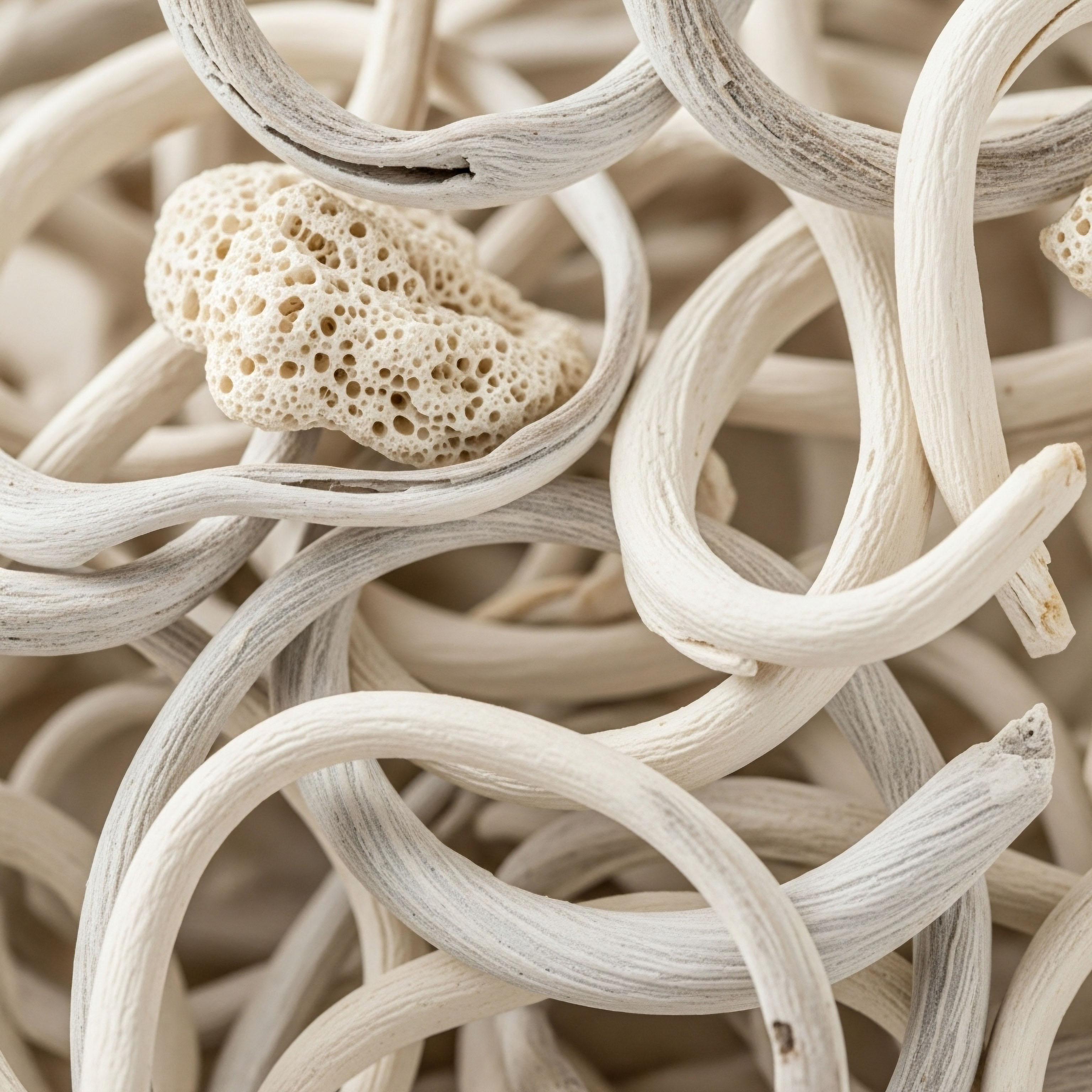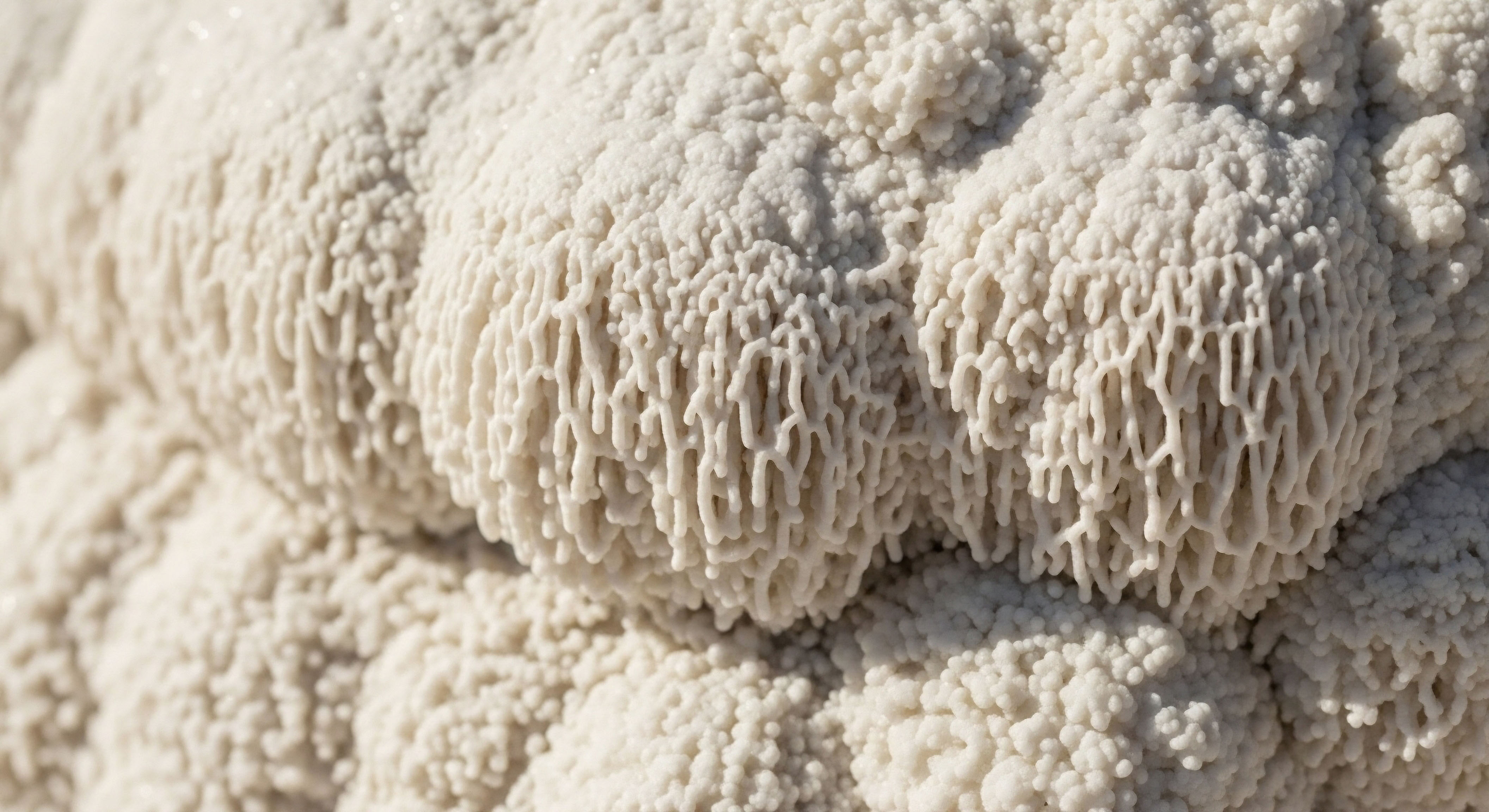

Fundamentals
The experience of desire is a deeply personal and often quiet aspect of our inner world. When it wanes, the sense of disconnect can be profound, leaving you to question what has shifted within your own biology.
The answer frequently lies not in a single, isolated cause, but within the intricate communication network of your body, a system where your daily choices in food and movement send powerful messages directly to your brain. This is where the conversation about sexual desire truly begins, in the silent, ongoing dialogue between your lifestyle and your neurochemistry.
The connection is intimate and direct; the foods you consume and the ways you move your body are primary architects of the neurotransmitter environment that governs arousal, motivation, and emotional connection.
At the center of this internal communication system are key neurotransmitters, particularly dopamine and serotonin. Dopamine is often characterized as the molecule of motivation and reward. Its release in the brain creates a feeling of pleasure and reinforces behaviors that lead to rewarding outcomes, which is a fundamental component of seeking out intimate experiences.
When dopamine pathways are robust, the drive to engage and the anticipation of pleasure are heightened. Conversely, serotonin, while essential for mood stability and feelings of well-being, has a more complex relationship with libido. Healthy serotonin levels contribute to a sense of intimacy and happiness, yet an excessive amount can dampen sexual desire. The balance between these two powerful neurochemicals is a delicate one, and it is directly and continuously influenced by your daily habits.
Your daily choices in nutrition and physical activity directly sculpt the neurochemical landscape that dictates sexual desire and arousal.
Consider your diet as a foundational tool for building these essential molecules. Neurotransmitters are synthesized from amino acids found in the protein-rich foods you eat. Dopamine, for example, is created from the amino acid tyrosine, which is abundant in foods like almonds, avocados, and lean meats.
Serotonin synthesis requires the amino acid tryptophan, present in turkey, eggs, and cheese. A diet lacking in these fundamental building blocks can impair your brain’s ability to produce adequate levels of these crucial communicators, leading to a diminished sense of motivation and desire.
Moreover, the health of your gut microbiome, the vast community of bacteria residing in your digestive system, plays a critical role. These microbes are instrumental in producing a significant portion of the body’s serotonin and influencing the production of other neurotransmitters.
A diet rich in fiber from fruits and vegetables nourishes a diverse and healthy gut, supporting this vital production line. The communication between the gut and the brain, known as the gut-brain axis, is a primary pathway through which diet shapes not only mood but also the intricate feelings associated with sexual health.
Physical activity operates as another potent modulator of this system. Regular exercise has been consistently shown to increase the release of dopamine, enhancing mood and motivation. This effect is not merely a fleeting “runner’s high”; consistent physical activity helps regulate and improve the efficiency of neurotransmitter systems over the long term.
It also helps manage stress by regulating cortisol levels. Chronic stress is a significant disruptor of hormonal and neurotransmitter balance, often leading to decreased libido. By engaging in regular movement, you are actively managing stress’s biochemical impact, creating a more favorable internal environment for desire to flourish.
The type of exercise matters less than the consistency. Whether it is brisk walking, weight training, or yoga, the act of moving your body sends a clear signal to your brain to optimize the very neurochemicals that support a healthy and active libido.


Intermediate
Understanding that diet and exercise influence desire is the first step. The next is to appreciate the precise mechanisms through which these lifestyle factors orchestrate the symphony of neurotransmitters and hormones that govern sexual function. This process is not random; it is a highly regulated system of feedback loops and biological pathways.
Think of the Hypothalamic-Pituitary-Gonadal (HPG) axis as the primary command center for your reproductive and sexual health. This axis is a continuous conversation between the brain (hypothalamus and pituitary gland) and the gonads (testes or ovaries).
It is this system that dictates the production of key sex hormones like testosterone, which is a primary driver of libido in both men and women. However, this axis does not operate in isolation. It is profoundly influenced by another critical system ∞ the Hypothalamic-Pituitary-Adrenal (HPA) axis, your body’s central stress response system.
When you experience chronic stress, the HPA axis goes into overdrive, continuously pumping out the stress hormone cortisol. Elevated cortisol can suppress the HPG axis, effectively turning down the volume on sex hormone production. This is a primitive survival mechanism; in times of high stress, the body prioritizes immediate survival over procreation.
Here is where lifestyle interventions become powerful tools for biochemical recalibration. Regular exercise, particularly activities like yoga and resistance training, has been shown to help regulate cortisol levels, thereby reducing the inhibitory pressure on the HPG axis. Similarly, a diet rich in anti-inflammatory foods ∞ such as those high in omega-3 fatty acids like salmon and walnuts ∞ can mitigate the chronic, low-grade inflammation that often accompanies a high-stress lifestyle, further supporting hormonal balance.

The Direct Impact of Nutrition on Neurotransmitter Synthesis
The food you consume provides the literal building blocks for the neurotransmitters that create the feeling of desire. This is a direct biochemical supply chain. A diet deficient in key nutrients can lead to a bottleneck in the production of dopamine and serotonin, directly impacting libido.
Specific nutrients in your diet act as essential cofactors in the enzymatic reactions that convert amino acids into mood-regulating neurotransmitters.
For instance, the conversion of tyrosine to L-DOPA, a precursor to dopamine, requires iron and vitamin B6 as cofactors. A deficiency in either can impair dopamine synthesis. Similarly, the journey from tryptophan to serotonin relies on adequate levels of vitamin B6 and magnesium.
This is why a holistic approach to wellness, one that may include hormonal optimization protocols, always begins with a nutritional assessment. Even with optimized hormone levels through treatments like Testosterone Replacement Therapy (TRT), a brain starved of the necessary nutrients will struggle to produce the neurotransmitters needed to translate hormonal signals into the subjective experience of desire. The table below outlines key nutrients and their roles in this process.
| Nutrient | Role in Neurotransmitter Balance | Dietary Sources |
|---|---|---|
| Tyrosine | Precursor to dopamine, the primary neurotransmitter for motivation and reward. | Chicken, turkey, fish, almonds, avocados, bananas |
| Tryptophan | Precursor to serotonin, which influences mood, intimacy, and sleep. | Oats, cheese, nuts, seeds, turkey |
| B Vitamins (B6, B9, B12) | Act as essential cofactors in the conversion of amino acids to neurotransmitters. | Leafy greens, legumes, eggs, fish, poultry |
| Magnesium | Supports serotonin production and has a calming effect on the nervous system. | Spinach, almonds, black beans, dark chocolate |
| Zinc | Plays a role in modulating dopamine production and testosterone levels. | Oysters, beef, pumpkin seeds, lentils |

How Does Exercise Reshape Brain Chemistry?
The impact of physical activity on brain chemistry extends far beyond a temporary mood lift. Consistent exercise induces neuroplastic changes, fundamentally altering how your brain produces and responds to neurotransmitters. Think of it as upgrading your brain’s internal communication hardware.
When you engage in regular physical activity, your brain increases the number and sensitivity of dopamine receptors. This means that not only are you producing more dopamine, but your brain is also becoming more efficient at using it. This enhanced dopamine signaling strengthens the reward pathways associated with pleasurable activities, including sex.
Furthermore, exercise boosts levels of brain-derived neurotrotrophic factor (BDNF), a protein that supports the survival of existing neurons and encourages the growth and differentiation of new neurons and synapses. This process of neurogenesis, particularly in the hippocampus, is linked to improved mood regulation and cognitive function, creating a more resilient and receptive mental state for intimacy.
For individuals on specific wellness protocols, exercise is a synergistic component. For men undergoing TRT, resistance training can enhance the therapy’s effects on muscle mass and body composition, which in turn can positively impact self-esteem and libido.
For women, exercise can help manage some of the symptoms associated with perimenopause, such as mood swings and sleep disturbances, by promoting a healthier neurotransmitter balance. In both cases, the combination of targeted clinical support and foundational lifestyle habits creates the most robust and sustainable path to revitalized well-being.


Academic
A sophisticated examination of how lifestyle influences sexual desire requires a systems-biology perspective, moving beyond isolated pathways to appreciate the deeply interconnected nature of our neuroendocrine and metabolic systems. The conversation is not simply about dopamine or testosterone in isolation; it is about the dynamic interplay between the gut microbiome, the immune system, metabolic health, and the central nervous system.
This integrated network, often termed the gut-brain-gonadal axis, represents the frontier of our understanding of how daily inputs like diet and exercise translate into complex human behaviors like sexual desire. The gut microbiota, in particular, has emerged as a master regulator in this system, capable of influencing everything from neurotransmitter synthesis to systemic inflammation and hormonal balance.
The gut microbiome, comprising trillions of microorganisms, functions as a highly active endocrine organ. Certain species of gut bacteria are capable of producing neurotransmitters directly, including serotonin, dopamine, and GABA. In fact, it is estimated that up to 90% of the body’s serotonin is produced in the gut by enterochromaffin cells, and this production is heavily influenced by the composition of the gut microbiota.
An imbalance in the gut, a state known as dysbiosis, can therefore lead to altered neurotransmitter availability, directly impacting mood and libido. This dysbiosis can be driven by a diet high in processed foods and low in fiber, which starves the beneficial bacteria that produce these essential compounds. Conversely, a diet rich in prebiotic fibers and fermented foods can foster a microbial environment conducive to optimal neurotransmitter production.

The Immunomodulatory Role of the Gut-Brain Axis
The gut is also the primary site of interaction between the external environment and the body’s immune system. The integrity of the intestinal barrier is paramount; a compromised barrier, often referred to as “leaky gut,” allows bacterial endotoxins like lipopolysaccharide (LPS) to enter the bloodstream.
This triggers a low-grade, chronic inflammatory response, which has profound implications for sexual health. Systemic inflammation activates the HPA axis, leading to elevated cortisol and suppression of the HPG axis, as previously discussed. Furthermore, inflammatory cytokines can directly interfere with neurotransmitter metabolism, shunting the precursor tryptophan away from serotonin production and towards the production of kynurenine, a metabolite associated with depression and fatigue.
The integrity of the intestinal barrier is a critical determinant of systemic inflammation, which directly modulates the neuroendocrine axes governing sexual function.
Exercise plays a crucial immunomodulatory role in this context. While intense, prolonged exercise can temporarily increase intestinal permeability, regular moderate exercise has been shown to strengthen the gut barrier and reduce systemic inflammation. It promotes the growth of beneficial bacteria that produce short-chain fatty acids (SCFAs) like butyrate.
Butyrate is the primary energy source for colonocytes, the cells lining the colon, and it plays a vital role in maintaining gut barrier integrity and exerting anti-inflammatory effects throughout the body. This mechanism provides a clear biochemical link between consistent physical activity and a reduction in the inflammatory burden that can suppress sexual desire.

Metabolic Health as a Mediator of Neurotransmitter Balance
The state of one’s metabolic health is inextricably linked to neurotransmitter function and hormonal balance. Insulin resistance, a hallmark of metabolic syndrome and type 2 diabetes, is a particularly potent disruptor of this delicate equilibrium. Chronically elevated insulin levels can lead to a host of downstream effects that are detrimental to libido.
For example, insulin resistance is often associated with lower levels of sex hormone-binding globulin (SHBG), a protein that binds to testosterone and makes it unavailable to tissues. Lower SHBG levels might seem beneficial, but in the context of insulin resistance, they are often accompanied by impaired testosterone production and increased aromatization of testosterone to estrogen, particularly in men.
This hormonal milieu is unfavorable for sexual desire. In women, insulin resistance is a key feature of Polycystic Ovary Syndrome (PCOS), a condition often characterized by hormonal imbalances and metabolic dysfunction.
Diet and exercise are the cornerstones of managing and reversing insulin resistance. A diet low in refined carbohydrates and high in fiber, healthy fats, and protein can help stabilize blood sugar and improve insulin sensitivity. Resistance training is particularly effective at improving insulin sensitivity by increasing glucose uptake into muscle cells.
By addressing metabolic health at this fundamental level, these lifestyle interventions correct the upstream dysfunctions that disrupt the sensitive neuroendocrine and hormonal systems responsible for sexual desire. This underscores why protocols aimed at hormonal optimization are most effective when built upon a solid foundation of metabolic health, driven by conscious choices in nutrition and physical activity.
The following list details the hierarchical influence of lifestyle factors on sexual desire, from the foundational to the systemic:
- Gut Microbiome Composition ∞ Directly influenced by dietary fiber and fermented foods, the gut microbiota produces neurotransmitters and metabolites like SCFAs that regulate systemic inflammation and gut barrier integrity.
- Intestinal Barrier Function ∞ Maintained by a healthy microbiome and moderate exercise, a strong gut barrier prevents the leakage of inflammatory molecules into the bloodstream.
- Systemic Inflammation ∞ Low levels of chronic inflammation, managed through an anti-inflammatory diet and regular exercise, prevent the suppression of the HPG axis and the disruption of neurotransmitter metabolism.
- Metabolic Health ∞ Improved insulin sensitivity, achieved through diet and exercise, ensures proper hormonal balance and prevents the downstream consequences of metabolic dysfunction on libido.
- Neurotransmitter and Hormone Balance ∞ The ultimate outcome of these interconnected systems, a balanced neurochemical environment is the direct prerequisite for healthy sexual desire.

References
- Di Vincenzo, A. et al. “Gut ∞ Brain Axis ∞ Focus on Sex Differences in Neuroinflammation.” International Journal of Molecular Sciences, vol. 25, no. 10, 2024, p. 5377.
- Lopresti, A. L. “The Effects of Psychological and Environmental Stress on Microbiota-Gut-Brain Axis in Humans ∞ A Systematic Review of Reviews.” Frontiers in Psychiatry, vol. 11, 2020, p. 407.
- “How To Increase Libido Naturally.” Life Extension, 2023.
- “What Factors Affect Libido (Sex Drive)?” Baptist Health, 2022.
- Melo, H. M. et al. “Bidirectional Association between Physical Activity and Dopamine Across Adulthood ∞ A Systematic Review.” Brain Sciences, vol. 12, no. 9, 2022, p. 1229.
- Mattson, M. P. “Sex-Dependent Metabolic, Neuroendocrine, and Cognitive Responses to Dietary Energy Restriction and Excess.” Endocrinology, vol. 148, no. 8, 2007, pp. 3649-60.
- “Working out boosts brain health.” American Psychological Association, 2020.
- Miller, K. K. et al. “Preservation of neuroendocrine control of reproductive function despite severe undernutrition.” The Journal of Clinical Endocrinology & Metabolism, vol. 89, no. 9, 2004, pp. 4434-8.
- “Dopamine and Libido ∞ The Neurotransmitter’s Role in Sexual Desire.” NeuroLaunch.com, 2024.
- “Gut-Brain Axis ∞ Understanding The Gut-Brain Connection.” Rupa Health, 2022.

Reflection
You have now seen the intricate biological wiring that connects your daily routines to your most private feelings of desire. The information presented here is a map, showing the profound influence of nutrition, movement, and stress modulation on the very chemistry of your vitality. This knowledge is the starting point.
It validates the lived experience that small, consistent actions can lead to significant shifts in well-being. The path forward involves looking at your own life, your own habits, and your own unique biology. What messages are you currently sending to your brain and body through your daily choices?
This journey of self-discovery is a personal one, and understanding the science is the first, most powerful step toward reclaiming your vitality on your own terms. The potential for recalibration and renewal resides within these daily decisions, waiting to be activated by your intention and commitment to your own health.



